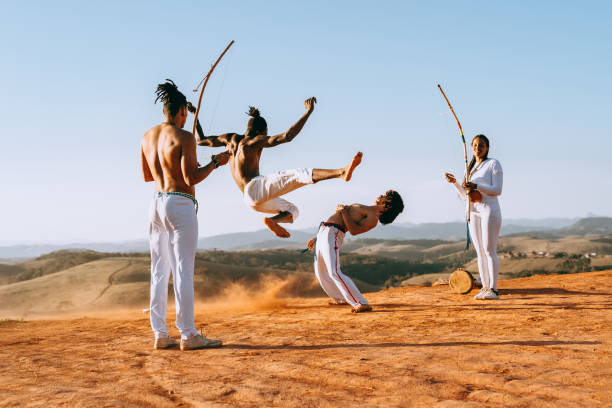Discovering Capoeira: Brazil's Enigmatic Martial Art Dance Fusion
Capoeira, a fascinating blend of martial art, dance, and music, traces its roots back to the 16th century in Brazil. This unique athletic discipline, born out of resistance and the struggle for freedom, has evolved into a captivating sports phenomenon practiced globally. With its rhythmic flow and acrobatic moves, Capoeira offers a new perspective on the world of sports, merging physical prowess, artistic expression, and historical significance.

A Historical Glimpse into Capoeira’s Origins
Capoeira’s origins lie within African slaves brought to Brazil by Portuguese colonizers in the 1500s. These slaves, hailing from diverse cultural backgrounds, sought a way to preserve their physical strength, cultural identity, and sense of community in a hostile environment. They cleverly disguised their martial arts training as a dance, complete with rhythmic music and singing, to avoid suspicion from their overlords. This ingenious camouflage allowed Capoeira to survive and flourish, becoming an important symbol of resistance and resilience.
Evolution and Recognition: From Taboo to National Treasure
The evolution of Capoeira was not always smooth. It faced significant challenges, including a complete ban in Brazil during the 19th century due to its association with rebellion and criminality. However, the prohibition only fueled its underground popularity. With the fall of the Brazilian Empire and the rise of the First Republic, Capoeira began to gain societal acceptance. By the mid-20th century, it was declared a national sport, and today, it’s recognized by UNESCO as an Intangible Cultural Heritage of Humanity.
The Dynamics of Capoeira: Music, Movement, and Mastery
At the core of Capoeira is the ‘roda,’ a circle formed by participants, within which the game, or ‘jogo,’ unfolds. The jogo is a choreographed duel between two players, called ‘capoeiristas,’ who engage in a series of swift, acrobatic movements, mimicking kicks and dodges. Accompanying the jogo are traditional music and call-and-response songs, setting the pace and mood of the encounter.
The Benefits and Challenges of Practicing Capoeira
Capoeira offers numerous physical benefits such as improved strength, flexibility, and cardiovascular health. It also fosters mental agility, concentration, and resilience. Additionally, it promotes a sense of community, cultural appreciation, and personal growth. However, mastering Capoeira can be challenging due to its complex techniques, need for rhythmic agility, and the necessity of understanding its historical and cultural context.
Capoeira in the Modern World: A Global Phenomenon
Today, Capoeira is practiced worldwide, reflecting its universal appeal. It has also found its way into mainstream media, featuring in films, video games, and fitness programs. While preserving its traditions, Capoeira continues to evolve, adapting to contemporary contexts and influencing other athletic disciplines.
In conclusion, Capoeira’s intriguing blend of martial art, dance, and music offers a refreshing perspective within the sports category. Its historical significance, dynamic nature, and global popularity ensure its relevance and appeal. As we delve deeper into the world of sports, it’s essential to recognize and appreciate such unique disciplines that enrich our understanding of human athleticism and cultural diversity.




